When it comes to wool yarn, there’s a common belief that it should never be exposed to water. But is that really true? Can wool yarn get wet without being ruined? We’ve got the answers you’re looking for.
Wool yarn can indeed get wet, but its water resistance depends on various factors, such as density, ply/texture, and quality. However, proper care is essential to maintain its quality and prevent damage. So, how should you care for your wool yarn when it gets wet? Let’s dive in and find out.
Key Takeaways:
- Wool yarn can get wet, but its water resistance depends on factors like density, ply/texture, and quality.
- Follow the care instructions on the label when washing wool yarn.
- Avoid wringing the yarn and opt for gentle soap flakes or woolwashes.
- Reshape and dry wool yarn flat away from direct sunlight.
- Using a damp pressing cloth can protect wool knits when ironing.
Washing Wool Yarn: A Practical Example
When it comes to washing wool yarn, it’s crucial to follow the care instructions provided on the label. Different yarns may require different methods of washing, such as dry cleaning or handwashing with soapflakes. Let’s take a look at a practical example of how to properly wash and care for wool yarn.
Gentle Handwashing
For most wool yarns, handwashing is recommended to preserve their quality. Start by filling a basin with lukewarm water and add a gentle shampoo formulated for delicate fibers. Using a gentle shampoo helps retain the natural oils in the yarn, keeping it soft and supple.
Care instructions for wool yarn:
Handwash with gentle shampoo and lukewarm water
Do not use harsh detergents or conditioners as they can strip the yarn of its natural oils and cause damage.
Removing Excess Water
After gently washing the yarn, it’s important to remove excess water without wringing or twisting the yarn. Wringing can cause felting and damage the delicate fibers, altering the texture and shape of the yarn.
Remove excess water by using a short spin in the dryer or carefully rolling the yarn in a towel. This process helps to eliminate excess moisture without compromising the integrity of the yarn.
Reshaping and Drying
Once excess water is removed, it’s time to reshape the yarn to maintain its original shape and texture. Lay the yarn flat on a clean surface, away from direct sunlight, to dry. Direct sunlight can fade the color of the yarn and deform its shape.
Reshaping the yarn while it’s still damp ensures that it maintains its original dimensions and appearance. Avoid hanging the yarn as this can lead to stretching and distortion.
If ironing is necessary, use a damp pressing cloth to protect the yarn from direct heat. Ironing wool knits without a pressing cloth can cause damage and change the texture of the yarn.
Avoid Frequent Washing
Frequent washing should be avoided as it can strip the yarn of its natural oils, making it dry and brittle over time. Instead, spot clean any minor stains or odors to maintain the yarn’s quality.
| Step | Instruction |
|---|---|
| 1 | Fill a basin with lukewarm water and add a gentle shampoo. |
| 2 | Submerge the wool yarn in the soapy water and gently agitate. |
| 3 | Drain the soapy water and refill the basin with clean lukewarm water. |
| 4 | Rinse the yarn by submerging it in the clean water and gently agitating. |
| 5 | Remove excess water by gently squeezing or rolling the yarn in a towel. |
| 6 | Reshape the yarn and lay it flat to dry away from direct sunlight. |
| 7 | If ironing is necessary, use a damp pressing cloth and low heat. |
Washing Cotton Yarn
When it comes to caring for cotton yarn, you’re in luck! Cotton yarn is generally easier to care for compared to other types of yarn, and it can usually be machine-washed. This makes it a convenient option for everyday use and frequent washing.
However, it’s important to note that some factors may affect the care instructions for cotton yarn. For instance, if the cotton yarn is not mercerized, there is a possibility of shrinkage during washing. To avoid any surprises, we recommend washing a gauge swatch along with your finished project. This way, you can test for any shrinkage and ensure the final dimensions are as expected.
When machine-washing cotton yarn, it’s best to use the “delicates” setting on both your washer and dryer. This setting is gentler and reduces the risk of damaging the yarn. It’s always a good idea to consult the specific care instructions on the label for each cotton yarn, as there may be additional recommendations or precautions to consider.

Remember, caring for your cotton yarn properly will help maintain its quality and appearance. By following the recommended care instructions, you can enjoy your cotton projects for years to come!
Washing Linen and Hemp Yarn
When it comes to caring for linen and hemp yarns, a little extra attention goes a long way. These plant fibers have unique properties that require special care during washing. While they may have an initially stiff or scratchy texture, each wash softens the yarn, creating a more pleasant touch. In fact, a harder wash with greater agitation and pressure can actually enhance the texture of the yarn. This is due to the fact that linen and hemp fibers, derived from the stalks of plants, are rich in cellulose.
Cellulose, the primary component of these yarns, contributes to their rigidity. However, when subjected to rough washing, the cellulose breaks down, resulting in a relaxed and softer yarn. So don’t be afraid to give your linen and hemp yarn a good wash to achieve maximum softness.
After washing, it’s important to lay the linen and hemp yarn flat to dry. This helps prevent excessive wrinkling and maintains the shape of your project. By following these care instructions, you can enjoy the benefits of beautifully soft and stylish linen and hemp creations.

Washing Acrylic Yarn
When it comes to washing acrylic yarn, you’ll be pleased to know that it can withstand quite a bit of abuse. Unlike other types of yarn, acrylic can be dried in heaps or tossed into the washing machine without any worries. Simply toss it in with your regular laundry detergent and let the machine do the work. It’s that easy!
However, there is one important thing to keep in mind: avoid ironing acrylic yarn. Acrylic fibers are prone to melting under high heat, so it’s best to skip the iron altogether. Instead, focus on drying and storing your acrylic projects properly to maintain their shape and integrity.
Remember, every type of yarn, including acrylic, may have specific care instructions. So, it’s always a good idea to check the label for any specific guidelines before washing acrylic yarn. Additionally, it’s recommended to knit a test swatch before washing a larger project to ensure that the yarn responds well to the washing process.
Key Points:
- Acrylic yarn can handle rough treatment and can be machine-washed with regular detergent.
- Avoid ironing acrylic yarn to prevent melting.
- Always check the label for specific care instructions and knit a test swatch before washing.

Superwash Yarns and Blends
Superwash yarns offer the convenience of machine-washing wool yarn without the fear of felting. These specially treated yarns undergo a process that coats the fibers, making them resistant to the traditional shrinkage and matting associated with wool. However, it’s essential to follow the care instructions provided by the manufacturer to maintain the yarn’s optimal condition.
We recommend washing superwash yarns on the delicate cycle to minimize friction and potential damage during the washing process. This gentle approach helps ensure that the yarn retains its softness and shape. After washing, it’s best to lay superwash yarn flat to dry, away from direct sunlight. This drying method promotes even drying and prevents distortion or stretching of the yarn.
When working with blended yarns containing different fibers, it’s essential to consider the care instructions for each fiber type. Blends can come in two forms: true blends and mixed yarns. True blends have the combined properties of both fibers, while mixed yarns have different plies made of distinct fiber types.
Table: Care Instructions for Blended Yarns
| Yarn Type | Care Instructions |
|---|---|
| Cotton-Wool Blend | Follow care instructions for superwash wool yarn; machine-wash on delicate cycle and dry flat. |
| Acrylic-Nylon Blend | Wash according to the care instructions for acrylic yarn; avoid high heat, and do not iron. |
| Linen-Silk Blend | Handwash gently with a mild detergent; reshape and lay flat to dry. |
Each blended yarn has its unique care requirements, so it’s crucial to refer to the label for washing techniques. By following the recommended care instructions, you can ensure that your superwash and blended yarns remain in excellent condition for years to come.

The Versatility of Superwash Yarns
Superwash yarns offer incredible versatility due to their machine-washable nature. They are ideal for garments and accessories that require frequent washing, such as baby items, socks, and everyday wearables. Moreover, the ability to blend different fibers in a single yarn opens up new possibilities for unique textures and properties.
Whether you’re knitting, crocheting, or weaving, superwash yarns provide the convenience of easy care without compromising on quality. Explore the wide range of superwash yarns available on the market, and unleash your creativity with confidence.
The Benefits of Using Wool Wash
When it comes to washing wool yarn, using a specialized wool wash, such as Soak, can offer numerous advantages. Wool wash contains soap or detergent that acts as a wetting agent, enhancing the yarn’s absorbency and allowing water to penetrate it more effectively. This increased wetness can be highly beneficial when it comes to wet blocking the knitted or crocheted items.
Wet blocking is a technique used to shape and relax the yarn, smoothing out any irregularities or inconsistencies in the knitting. By soaking the project in a wool wash solution and then placing it in the desired shape, the yarn can be reshaped to ensure a more professional and polished result. Wool wash helps in this process by making the yarn wetter, facilitating greater pliability and easier manipulation.
In addition to wet blocking, using wool wash can also improve the overall appearance of stitches. The soap or detergent in the wool wash solution can help straighten and refine the stitches, resulting in a neater and more polished look. This is especially beneficial when working with intricate stitch patterns or cables, enhancing the clarity and definition of each stitch.
Another advantage of using wool wash is the potential for softer and smoother yarn. The gentle formula of wool wash helps to maintain the natural oils present in the wool, preserving its softness and preventing it from becoming dry or brittle. This results in a final product that is not only visually appealing but also pleasant to touch.
table { width: 100%; border-collapse: collapse; } th, td { padding: 8px; text-align: left; border-bottom: 1px solid #ddd; } th { background-color: #f2f2f2; }| Benefits of Wool Wash |
|---|
| Enhances absorbency and water penetration |
| Facilitates wet blocking for better shaping |
| Improves appearance of stitches |
| Leaves the yarn softer and smoother |

With these benefits in mind, using wool wash can greatly enhance your knitting or crochet projects. It not only ensures effective cleaning but also helps in achieving professional-looking results. Whether you’re a beginner or an experienced crafter, incorporating wool wash into your fiber care routine can make a noticeable difference.
Testing the Effects of Wool Wash
To understand the impact of wool wash on knitting, we conducted a test using Lucky Tweed yarn. We wanted to compare the results of washing the yarn with water only to using a solution of Soak wool wash and water.
We knitted two swatches using the Lucky Tweed yarn, one for each washing method. The first swatch was soaked in water, while the second swatch was soaked in a solution of Soak wool wash and water.

After soaking the swatches, we observed noticeable differences in the results. The swatch soaked in the wool wash solution showed improved evenness and stitch appearance compared to the swatch washed with water only.
The wool wash seemed to help straighten rowed-out stitches, resulting in a smoother overall swatch. Additionally, the use of wool wash contributed to better blocking and a more relaxed and pliant feel of the yarn.
Comparison of Swatches
| Swatch | Washing Method | Results |
|---|---|---|
| Swatch 1 | Water Only | Uneven stitches, rowed-out stitches |
| Swatch 2 | Soak Wool Wash and Water | Improved evenness, straightened stitches, smoother texture |
Based on our test, it is evident that using wool wash can have a positive impact on the appearance and texture of knitted projects. The wool wash helps to enhance the overall quality and ensures a more professional finish.
Overall, this test highlights the importance of considering the type of wash used when caring for wool yarn. By using a wool wash solution, you can achieve better results in terms of stitch appearance, evenness, and overall knitting quality.
Conclusion
Proper care is crucial for maintaining the quality of wool yarn. To ensure that your woolen projects stay in pristine condition, it is important to follow a wool yarn care guide and adhere to proper washing techniques. Start by reading and following the care instructions on the label, as they provide specific guidance for each yarn. Use gentle soap flakes or wool washes when washing wool yarn, avoiding harsh detergents that can strip the yarn of its natural oils. Remember to never wring the yarn, as this can cause damage. Instead, gently remove excess water by using a short spin in the dryer or rolling the yarn in a towel.
When drying wool yarn, avoid direct sunlight, as this can cause color fading. Instead, reshape the yarn and lay it flat to dry. By taking these precautions, you can preserve the shape and color of your woolen projects. It’s also important to note that frequent washing should be avoided, as it can lead to the loss of natural oils, resulting in dry and brittle yarn.
By following these proper care techniques and maintaining the quality of your wool yarn, you can ensure that your knitting and crochet projects not only look beautiful but also stand the test of time.









